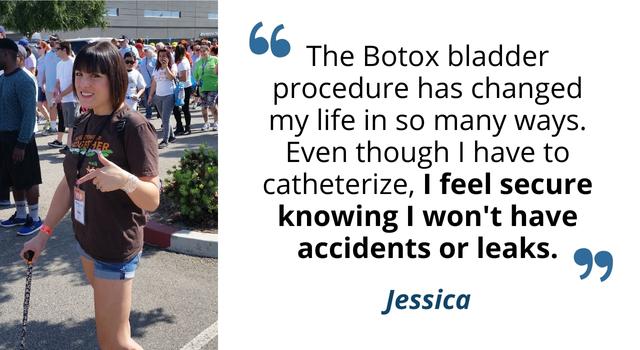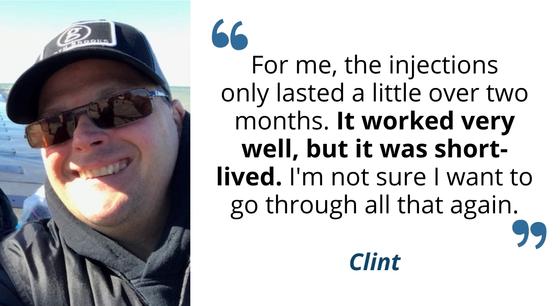
Have you heard about Botox bladder injections? The use of Botox as a treatment for urinary incontinence and overactive bladder is gaining traction. Let’s take a closer look at the Botox bladder injection procedure, including its potential benefits, risks and side effects, and more.
1. What are Botox bladder injections?
This relatively quick procedure involves injecting a small amount of botulinum toxin into the bladder muscle to treat urinary leakage, urge incontinence, and overactive bladder.
Botox, or botulinum toxin, is a medication derived from the bacteria Clostridium botulinum. It has become a popular choice for aesthetic treatments to reduce facial wrinkles and fine lines. However, in recent decades, this same muscle-relaxing benefit has been shown to help reduce overactive bladder contractions and provide better control over urination for some individuals with urinary incontinence or overactive bladder.
These bladder injections are also FDA-approved.

Botox bladder injections are a minimally-invasive procedure that may take as little as 30 minutes to complete for some. It is usually done under local or sometimes general anesthesia. A solution to numb the bladder is administered via a urethral catheter first. Then a scope and the needle are inserted so the doctor can view the area while performing the injections.
This procedure is generally safe and well-tolerated. Talk to your doctor to see if bladder injections may be right for you.
2. What are the benefits of Botox bladder injections?
From carrying around incontinence supplies to inconvenient urine leaks, bladder issues can impact the quality of one’s life. Some studies indicate that urinary incontinence symptoms may be associated with a higher risk of depression.
The primary benefit of the Botox procedure for overactive bladder is that it may offer relief or a reduction in symptoms of urine leakage without the need for more invasive surgery. If it successfully reduces those symptoms, the Botox bladder procedure may also help improve the quality of life for people with incontinence-related anxiety or depression.
According to one study published in the National Library of Medicine, Botox bladder treatment resulted in a 60 to 80% decrease in urinary incontinence episodes.
Also, this procedure may be effective for individuals who have not seen improvement from other treatments like medication or lifestyle changes such as Kegel exercises. However, keep in mind that results may vary from person to person.
Some potential benefits of Botox injections in the bladder may include:
- Reduced frequency of urination
- Reduced urgency (urge incontinence)
- Fewer accidents or leaks
- Potentially improved quality of life
3. Are the results of Botox injections in the bladder permanent?
No, this medical procedure is not intended to provide permanent results. While this procedure does not cure bladder incontinence permanently, it can provide relief from symptoms for several months at a time, depending on the individual and their anatomy.

Effects typically last between 3 to 6 months, although some people may see improvement for longer stretches of time. This depends on the individual and their unique anatomy. It may also depend on how the injection was administered.
As the effects wear off, another round of injections will be needed to maintain the desired results.
4. Are there risks or side effects of having bladder injections?
As with any medical procedure, injections in the bladder do have some potential risks.
Some potential temporary side effects of bladder injections may include:
- Small amounts of blood in urine
- Abdominal discomfort
- Dizziness or faintness
- Possible increased risk of UTIs
These problems should eventually subside without further treatment once your body adjusts to the medication injected into your bladder muscle wall.
Also, some individuals may find an increase in urinary bladder retention. In other words, the bladder muscle may go from being overactive to underactive. This may require using an intermittent catheter to help empty the bladder several times daily, but for some people, this may only be temporary.
5. Are Botox bladder injections painful?
This procedure should not be very painful since it is usually performed with a local anesthetic. However, it may not exactly be comfortable either.
Talk to your doctor to see if they have any other recommendations for pain management during or after the procedure.
6. How should I prepare for my bladder injection procedure?
Your doctor, urologist, nurse, or healthcare team should be able to give you personalized recommendations and medical advice when preparing for your Botox bladder procedure.

You may also need to provide a urinalysis or urine test beforehand so your doctor can ascertain whether your bladder also has any symptoms of retention or if you have an infection.
Depending on the type of administered anesthesia, you may want to bring a guest (usually a family member or partner) who can drive you home after the procedure. However, there’s usually no downtime with this procedure, making it a great option for busy folks.
Also, some medical professionals might advise you to avoid caffeine and certain types of medications beforehand if it could interfere with the effectiveness of the procedure.
Before and after your injections, be sure to follow all of your doctor’s recommendations.
7. Will I still need to use catheters or incontinence products after Botox injections?
Some people see a complete improvement in their urine leakage symptoms. However, it’s possible that you may still need to use incontinence supplies as a backup for occasional light leakage. If the procedure is successful, it will help reduce the severity of those symptoms.
Some people who receive Botox injections and have urinary bladder retention may need to continue using catheters based on their doctor’s recommendations. This helps ensure the bladder is fully emptying and not retaining urine, which could cause infection.
This need may be temporary or permanent, based on the individual’s needs before and after the procedure.
Experiences of Bladder Injections From Real 180 Medical Customers
Sometimes, it helps to hear from someone who has been through a procedure you’re considering. Here are two experiences of going through Botox bladder injections from real 180 Medical customers.
Jessica’s Experience
180 Medical customer Jessica shared that, because of her diagnosis of Multiple Sclerosis and neurogenic bladder, she was completely incontinent and unable to control her bladder.
“My urologist and neurologist suggested the bladder Botox procedure about 11 years ago,” Jessica told us. “The first time I had the procedure, I was put under anesthesia. It was very quick. I have to repeat the procedure once every three months, but I’ve heard of others who only go once a year. It’s not painless, and it can be uncomfortable, but I learned not to be afraid and what to expect after the first few times. It has, however, changed my life in so many ways. Even though I have to catheterize to empty my bladder, I feel secure knowing I won’t have accidents or leaks. I don’t have constant stress over bladder problems anymore.”

Clint’s Experience
Clint, another member of the 180 Medical community, has been living with a neurological disorder that impacted his bladder since he was 19 years old. When his doctor suggested Botox as a treatment option, he gave it a shot.
“They said it could last up to a year, but for me, it only lasted about two and a half months,” said Clint. “During the procedure, they put me to sleep so they could go into the bladder and inject the muscle. It worked very well, but it was short-lived. Around three months later, all my symptoms were completely back to where it was before the procedure. I’m not sure I want to go through all that again.”

Sometimes, this procedure isn’t the right fit for everyone, and another treatment option should be looked at with your doctor. In Clint’s case, he went through a urodynamics study, which showed he had bladder retention and an overactive bladder.
“That’s when my doctor recommended intermittent self-catheterizing and sent me to 180 Medical for my supplies.”
Are Botox bladder injections right for you?
Botox injections may be an effective treatment option for some people who want relief from their urinary incontinence issues.
If you’re considering Botox injections, talk to your doctor to ensure it’s right for you. Be sure to ask them any questions or concerns you have about the risks, symptoms, or potential results before proceeding. You should be able to have all the information you need to make an informed choice for your health and quality of life.
Disclaimer: This is not a product endorsement or medical advice. This information is intended to provide a general understanding of the botulinum toxin bladder injection medical procedure. Do not use this information in place of a visit, call, or consultation with a qualified physician or another healthcare provider.
